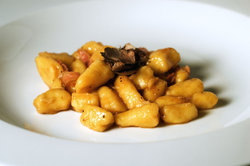Gnocchi
Gnocchi (pronounced NYO-ki; [ˈɲjɒkːi]) is the Italian word for dumplings; in Italian, gnocchi is the plural of gnocco, which literally means "lump". They can be made of potato and semolina (durum wheat) or flour, ricotta cheese (with or without spinach), or semolina. Although the dish is Italian, the word comes from a Germanic word for a knot (as in wood), possibly because of its short, squat shape. Gnocchi are often listed among pasta dishes, although gnocchi has different ingredients and mode of preparation.
Gnocchi are easy to make and provide a filling meal. An example recipe:
Take 1½ cups of leftover mashed potatoes, add 1 egg yolk and mix until well combined. Add ½ cup of flour to make a crumbly dough. Tip it onto a floury counter and knead in more flour until it's smooth and not sticky. Roll it into 2 cm-thick ropes and cut into little pillows. If you want, you can roll the pillows over the tines of a fork with your thumb to give them a gnocchi's distinctive shape (ridged on one side with a big dent on the other.) Cook them in boiling salted water in batches for 30 seconds or until they float to the top of the water. Serve immediately with butter, grated Parmesan cheese and black pepper or your favorite sauce.
Gnocchi cook faster than normal pasta and can fall apart if overcooked. Most people buy their gnocchi premade, which are cooked just like fresh gnocchi. The classic accompaniments of gnocchi are a tomato sauce, a brown butter and sage sauce or melted butter and cheese.

In the Tuscan area of Italy, spinach-and-ricotta-flavored gnocchi are called strozzapreti, or priest-stranglers. Apparently a priest choked and died after eating too quickly, because the gnocchi were so delicious.
In Argentina, where Italian cuisine is especially popular, gnocchi (known as ñoquis) are traditionally eaten on the 29th day of each month. This was the day before payday, when people were at their poorest. Ñoquis made a cheap and hearty meal. On these occasions, some people leave a banknote under the plate to attract prosperity. Now in Argentine communities outside the country, Argentines gather each month for "ñoquis del 29".
In a curious reversal of meaning, in Argentine slang ñoqui has also become a way to denote a government employee that is listed in the payroll but only shows up to collect his or her paycheck around the 29th of each month.
References
- Jenkins, Nancy Harmon. Flavors of Tuscany. 1998.
External links
| Pasta | |
|---|---|
| Agnolotti | Bigoli | Bucatini | Cannelloni | Farfalle | Fettuccine | Fusilli | Gnocchi | Lasagne | Linguine | Macaroni | Pappardelle | Penne | Pizzoccheri | Ravioli | Rigatoni | Spaghetti | Tagliatelle | Tortellini | Trenette | Ziti | |
| Total List of Pasta |
